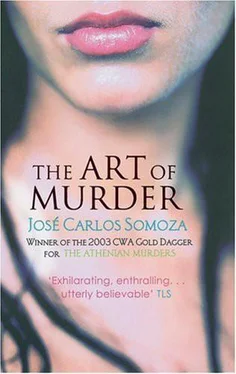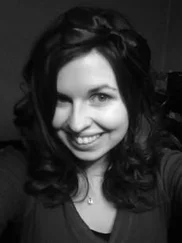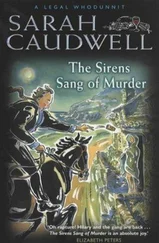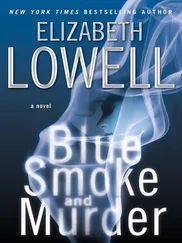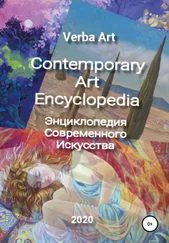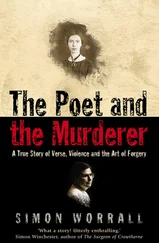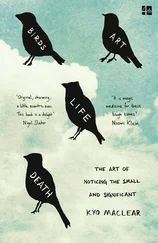Jose Somoza - Art of Murder
Здесь есть возможность читать онлайн «Jose Somoza - Art of Murder» весь текст электронной книги совершенно бесплатно (целиком полную версию без сокращений). В некоторых случаях можно слушать аудио, скачать через торрент в формате fb2 и присутствует краткое содержание. Жанр: Триллер, на английском языке. Описание произведения, (предисловие) а так же отзывы посетителей доступны на портале библиотеки ЛибКат.
- Название:Art of Murder
- Автор:
- Жанр:
- Год:неизвестен
- ISBN:нет данных
- Рейтинг книги:4 / 5. Голосов: 1
-
Избранное:Добавить в избранное
- Отзывы:
-
Ваша оценка:
- 80
- 1
- 2
- 3
- 4
- 5
Art of Murder: краткое содержание, описание и аннотация
Предлагаем к чтению аннотацию, описание, краткое содержание или предисловие (зависит от того, что написал сам автор книги «Art of Murder»). Если вы не нашли необходимую информацию о книге — напишите в комментариях, мы постараемся отыскать её.
Art of Murder — читать онлайн бесплатно полную книгу (весь текст) целиком
Ниже представлен текст книги, разбитый по страницам. Система сохранения места последней прочитанной страницы, позволяет с удобством читать онлайн бесплатно книгу «Art of Murder», без необходимости каждый раз заново искать на чём Вы остановились. Поставьте закладку, и сможете в любой момент перейти на страницу, на которой закончили чтение.
Интервал:
Закладка:
Art of Murder
Jose Carlos Somoza
INTRODUCTION
The teenage girl stands naked on the plinth. Her smooth stomach and the dark curve of her navel are at eye level. She is looking down with her head tilted to one side, one hand shielding her pubis, the other on her hip. Her knees are together and slightly bent. She is painted in natural sienna and ochre. Shading in burnt sienna emphasises her breasts and moulds her inner thighs and her little slit. We should not say 'slit' because this is a work of art we are talking about, but when we see her, that is what we think. A tiny vertical slit, stripped of all hair. We walk round the plinth and observe the figure from the back. The tanned buttocks reflect patches of light. If we step away, her anatomy acquires a more innocent look. Her hair is strewn with small white flowers. More flowers surround her feet – a pool of milk. Even at this distance we can still pick up the strange scent she gives off, like the smell of wood after rain. Next to the security rope is a little stand with the title in three languages: Deflowering.
A two-note loudspeaker chime breaks the spell: the museum is about to close. A young woman's voice says so in German, then in English and French. Everyone seems to understand, or at least gets the intended message. The teacher of a select Viennese secondary school gathers her uniformed flock and counts them to make sure no one is missing. Even though the exhibition is of nudes, she has taken the children to see it. It is of no importance, they are works of art. What matters to the Japanese is that they have not been allowed to take photos: that is why none of them is smiling as they file out. They console themselves at the exit, where they can buy catalogues for fifty euros with full-colour photographs. A nice souvenir of Vienna.
Ten minutes later, after the room has emptied of visitors, something unexpected happens. Several men arrive, wearing ID tags in their suit lapels. One of them goes up to the plinth where the young girl is standing and says out loud:
'Annek.' Nothing happens. 'Annek,' he says again.
The eyes blink, the neck straightens, the mouth opens, the body shudders, and the budding breasts heave as she takes a deep breath.
'Can you get down on your own?' She nods, but hesitates. The man holds out his hand.
Eventually the girl manages to descend from the plinth, trailing a cloud of petals in her wake.
Annek Hollech opened the first bottle from the rack by the chrome metal shower, and the water turned green. She opened the second and rubbed herself with red water. After that, she soaked herself in blue, then purple. Each of the liquids in the bottles took off only one of the four products which had been applied to her skin: paints, oils, hairspray, artificial aromas. The bottles were numbered and each showed their purpose by turning the water a different colour. The paints and sprays were the first to come off, in a shower of drops. As always, the hardest thing to get rid of was the smell of wet earth. The cubicle filled with steam, and Annek's body disappeared behind a rainbow-coloured curtain. Each of the other twenty cubicles in the room was occupied by a shadowy silhouette. The only sound was the hiss of the showers.
Ten minutes later, enveloped in towels and mist, Annek walked barefoot to the dressing room. She dried herself off, combed her hair, rubbed first a moisturising and then a protective cream all over her body – using a long-handled sponge to reach her back – and protected her face with two layers of cosmetics. Then she opened her locker and took out her clothes. They were all new, purchased in shops on the Judengasse, Kohlmarkt, the Haas Haus and the elegant Karntner street. She liked to buy clothes and accessories in the cities where she was on show. During the seven weeks she had been in Vienna she had also bought porcelain and glassware and sweets from Demel's, as well as a few trinkets for her friend Emma van Snell, who was also a work of art but was being exhibited in Amsterdam.
On that Wednesday 21 June, 2006, Annek had gone to the museum wearing a pink blouse, military jacket and a pair of baggy trousers full of pockets. Now she took these clothes out of the locker and put them on. She did not wear anything underneath – it wasn't recommended if one was on show completely naked (underwear leaves marks). She put on a pair of felt slippers in the shape of two little bears, fastened her black slimline watch on to her wrist and picked up her bag.
Sitting next to her in the labelling room was Sally, the work of art on plinth number eight. She was wearing a sleeveless mauve blouse and a pair of jeans. They said hello and Sally commented:
'Hoffmann says my purple's fading like Van Gogh's yellows. He wants to try a more intense colour, but in Conservation they're worried it might damage my skin. Wouldn't you know it? The same old contradiction: some people want to create you, others want to conserve you.' That's true,' Annek said.
An assistant came over carrying two boxes of labels. Sally opened hers and picked out one of them.
‘I can't wait to get to bed,' she said. ‘I don't think I'll go to sleep straightaway, I'll just lie there on my back, stare at the ceiling and enjoy being horizontal again. What about you?' ‘I have to call my mother first. I phone her every week.' 'Where is she now? She travels a lot, doesn't she?'
'Yes. She's in Borneo, taking pictures of monkeys.' Annek put one of the labels round her neck and fastened it. 'Sometimes she emails photos of monkey couples.' 'Really?'
'Yes, really. I'm not sure whether she's trying to tell me I should get married or what.' Sally laughed quietly behind two rows of perfect white teeth.
'At least she sends you something. My father in New York can't even be bothered to scan in a couple of hotdogs for me. He never liked the idea of his daughter becoming a valuable work of art.'
Silence. Annek did up the last label round her ankle. Her neck, wrist and ankle now boasted three 8 x 4cm labels, painted bright yellow and tied with black strings. Sally had also finished doing up hers. They watched as the first works of art left the room: Laura, Cathy, David, Estefania, Celia. A parade of athletic, labelled figures.
'I haven't had my period again this month,' Annek said expressionlessly. ‘It's been irregular since Hamburg.' Sally looked at her for a moment.
‘It’s not important, it happens to all of us. Lena reckons it's like an umbrella: first she has one, then she loses it, then she has one again, but then she loses it yet again. It's all part of being a work of art, you know.'
'Yes, I know,' Annek was still staring into the mirror. 'And anyway, I feel better when I don't have one.' 'Hey, have you got anything planned for next Monday?'
The question puzzled Annek. She never planned anything for the day the museum was closed, apart from her frenetic shopping sprees with her inexhaustible credit card. Everything else -the solitary walks in the Hofburg, Schonbrunn, or Belvedere – which were not in fact so solitary because she was always accompanied by bodyguards – or visits to the Art History Museum or Saint Stephen's cathedral, even the ballets and performances put on for Vienna's June festival left her feeling bored and slightly nauseous. She wondered what a work of art like her was doing in this kind of city, where everything was art. She was looking forward to the time when the tour left Europe. The next year, 2007, the Foundation had promised them they would be travelling to America and Australia. Perhaps she could find something there she would really enjoy doing. 'Nothing,' she replied. 'Why?'
'Laura, Lena and I thought we might spend the whole day at the Prater fun fair. Want to come along?' 'OK.'
Читать дальшеИнтервал:
Закладка:
Похожие книги на «Art of Murder»
Представляем Вашему вниманию похожие книги на «Art of Murder» списком для выбора. Мы отобрали схожую по названию и смыслу литературу в надежде предоставить читателям больше вариантов отыскать новые, интересные, ещё непрочитанные произведения.
Обсуждение, отзывы о книге «Art of Murder» и просто собственные мнения читателей. Оставьте ваши комментарии, напишите, что Вы думаете о произведении, его смысле или главных героях. Укажите что конкретно понравилось, а что нет, и почему Вы так считаете.
